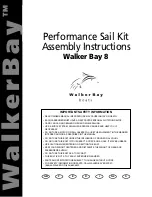
SECTION 4 – BOOM
4-2
USTC
January 15, 2001
Hoist
Spool
Figure 4-3. Hoist Cable Spooling
The American National Standard for crane safety
(ANSI B30.5b-1991) states:
Conditions such as the following shall be sufficient
reason for questioning continual use of the (cable)
or increasing the frequency of inspection:
1. In running ropes, six randomly distributed
broken wires in one lay or three broken wires in
one strand in one lay.
2. One outer wire broken at the point of contact
with the core of the rope which has worked its
way out of the rope structure and protrudes or
loops out from the rope structure. Additional in-
spection of this section is required.
3. Wear of one-third the original diameter of out-
side individual wires.
4. Kinking, crushing, bird-caging or any other
damage resulting in distortion of the rope struc-
ture.
5. Evidence of any heat damage from any cause.
6. Reductions from nominal diameter of more
than;
a. 1/64 in. (0.4 mm) for diameters up to and
including 5/16 in. (8.0 mm);
b. 1/32 in. (0.8 mm) for cable diameters of
3/8 in. (9.5 mm) to and including 1/2 in.
(13.0 mm).
c. 3/64 in. (1.2 mm) for diameters 9/16 in.
(14.5 mm) to and including 3/4 in. (19.0 mm).
Note: A good indicator of stretched extend/retract
cables is if the adjusting nuts are bottomed out. If no
adjustment remains the cables have stretched and
need replacement.
Also, check for cracked, bent, worn, severely cor-
roded, or improperly installed cable ends.
Inspect sheave grooves for excessive wear.
IMPORTANT: To establish a basis for judging the
proper time for cable replacement, a dated cable
condition report from each periodic inspection shall
be kept on file. Per ANSI specifications, replacement
parts shall have a strength rating at least as great as
the original any deviation from the original must be
specified by the manufacturer, a wire ripe
manufacturer or a qualified person.
Note: Cable must be spooled onto hoist in same
direction as removal from spool.
HOIST CABLE
Installation and Attachment Procedure
1. From top of spool route cable over top idler
sheave.
2. Continue routing cable along base boom and
anchor to hoist drum.
3. Keeping cable tight as possible, operate hoist
and spool cable onto drum using a brass mallet
to assure cable wraps properly.
4. If using multi-part line, properly reeve cable
through sheave wheels of boom nose and hook-
block assembly.
5. Attach cable to wedge socket. Attach wedge
socket assembly to attaching link on bottom of
boom nose.
Figure 4-2. Measuring Wire Rope
CORRECT
INCORRECT
Содержание 2500 jbt
Страница 16: ...SECTION 1 SPECIFICATIONS 1 8 USTC January 15 2001 Courtesy of Crane Market ...
Страница 22: ...SECTION 2 INSPECTION 2 6 USTC January 15 2001 Courtesy of Crane Market ...
Страница 62: ...SECTION 5 SWING DRIVE 5 10 USTC January 15 2001 Courtesy of Crane Market ...
Страница 74: ...SECTION 6 ELECTRICAL 6 12 USTC January 15 2001 Figure 6 11 Clam Shell 1282077 Rev A Courtesy of Crane Market ...
Страница 83: ...SECTION 7 HYDRAULICS 3120933 Rev 0 USTC 7 9 Figure 7 6 Control Valve Linkage Courtesy of Crane Market ...
Страница 91: ...SECTION 7 HYDRAULICS 3120933 Rev 0 USTC 7 17 Figure 7 15 Overload 1282330 Rev C Courtesy of Crane Market ...
Страница 95: ...SECTION 7 HYDRAULICS 3120933 Rev 0 USTC 7 21 Figure 7 19 Emergency Down 2792484 Rev Courtesy of Crane Market ...
Страница 98: ...SECTION 7 HYDRAULICS 7 24 USTC January 15 2001 Powered by TCPDF www tcpdf org Courtesy of Crane Market ...
















































